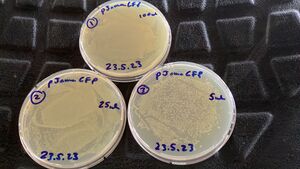Difference between revisions of "Validated GMO inactivation"
| Line 3: | Line 3: | ||
In order to more formally validate the usual GMO inactivation done with bleach for disposal of plates and cultures, we are adding this page. This validation was performed with two brands of commercial bleach and is applicable to both GMO bacteria and nematode worms transformed with antibioticR plasmids. It is directly specific for [https://drive.google.com/file/d/1_db3H7Ybm_kd7yV-wnMKF55Snr805TAp/view?usp=sharing this SOP] of the lab collection. | In order to more formally validate the usual GMO inactivation done with bleach for disposal of plates and cultures, we are adding this page. This validation was performed with two brands of commercial bleach and is applicable to both GMO bacteria and nematode worms transformed with antibioticR plasmids. It is directly specific for [https://drive.google.com/file/d/1_db3H7Ybm_kd7yV-wnMKF55Snr805TAp/view?usp=sharing this SOP] of the lab collection. | ||
| − | + | As always, precautions in using bleach and appropriate personal protective equipment (lab coat, gloves, and eye protection) are an essential part of this inactivation method. | |
| + | |||
| + | The big white tray - labelled 'clean up' - was used, as usual for all manipulations. | ||
| + | |||
| + | |||
| + | The validation for bacterial plates was done upon bacteria transformed with a pJAMA-GFP plasmid, which make bright green colonies... | ||
| + | |||
| + | A fresh 2ml culture was used to make three plates of cultures on growth media carrying the selective antibiotic, ampicillin (LB-amp100 plates). | ||
| + | |||
| + | 1, with 100ul of culture (full lawn) | ||
| + | |||
| + | 2, with 25ul of culture (less bugs) | ||
| + | |||
| + | 3, with 5ul of culture (still too many to count) | ||
| + | |||
| + | These are shown below: | ||
| + | [[File:Colonies for inactivation test.jpg|thumb|Plates used for bacterial colonies]] | ||
| + | |||
| + | |||
| + | |||
| + | Then, the plates were treated with bleach. | ||
Revision as of 15:05, 15 November 2023
In order to more formally validate the usual GMO inactivation done with bleach for disposal of plates and cultures, we are adding this page. This validation was performed with two brands of commercial bleach and is applicable to both GMO bacteria and nematode worms transformed with antibioticR plasmids. It is directly specific for this SOP of the lab collection.
As always, precautions in using bleach and appropriate personal protective equipment (lab coat, gloves, and eye protection) are an essential part of this inactivation method.
The big white tray - labelled 'clean up' - was used, as usual for all manipulations.
The validation for bacterial plates was done upon bacteria transformed with a pJAMA-GFP plasmid, which make bright green colonies...
A fresh 2ml culture was used to make three plates of cultures on growth media carrying the selective antibiotic, ampicillin (LB-amp100 plates).
1, with 100ul of culture (full lawn)
2, with 25ul of culture (less bugs)
3, with 5ul of culture (still too many to count)
These are shown below:
Then, the plates were treated with bleach.
